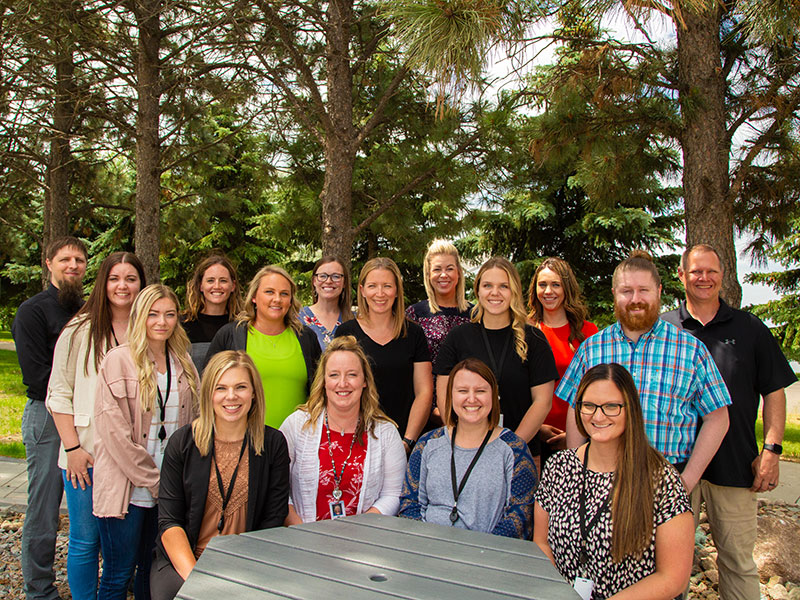- Products
- About us
- Responsibility
- Environment
- News
- Contact us
- Careers
-

Back row: Joe Thomas, senior business systems analyst; Mikayla Mittelsteadt, accounting analyst II; Whitney Fischer, senior financial operations analyst; Courtney Fisher, financial analyst III; Kristin Brandt, manager of Financial Operations; Kayla Konschak, financial analyst II; Chris Wilmes, senior enterprise application administrator. Second row: Jennifer Koch, accounting analyst I; Ashley Sundquist, senior accounting analyst; Maria Glasser, accounting analyst III; Alexis Betz, accounting analyst I; Jackson Carlson, support center representative I. Front row: Andrea Diehl, senior accounting analyst; Jodi Schlatter, accounting analyst III; Kate Schlag, manager of Accounts Payable; Molly Glassheim, accounting analyst I.
Employees at Basin Electric work hard every day figuring out ways to improve processes and to stay current on the latest technology, and they do this by collaborating with each other on various projects and tasks. Recently, several teams put their heads together to change how and when a vendor is paid.
As part of a shared team initiative, the Accounts Payable and Financial Operations groups decided to convert more vendors to electronic payments to help reduce the number of physical checks being sent out. “Because the number of checks being cut has drastically decreased over the past couple of years, it made sense to move from daily check printing to bi-weekly check printing,” says Kristin Brandt, Basin Electric manager of Financial Operations.
Conversations were spurred on by Brandt and Todd Brickhouse, Basin Electric senior vice president and chief financial officer, in a manager’s meeting, and when Brandt brought up the idea of bi-weekly printing, Brickhouse said, “Let’s make it happen.” Together with Information Services and Telecommunications, the teams began figuring out a way to make the switch.
To start the process, changes needed to be made to Asset Suite, an asset management software. “When we first talked about reducing the amount of check runs, I was open to the idea if we could do it without paying our vendors late,” says Kate Schlag, Basin Electric manager of Accounts Payable. Prior to the change, checks were cut daily so invoices would pay on their due dates. Limiting the number of check runs to twice a week without changing how invoices were pulled could have resulted in late fees or being put on credit hold, which could delay orders. The team needed the ability to pay some invoices a day or two before they were due. Paying invoices on time helps to create strong relationships with a vendor.
Chris Wilmes, Basin Electric senior enterprise application administrator, did some research into the functionality within Asset Suite. During that research, Wilmes and Melissa Carlson, Basin Electric enterprise application architect III, learned how complicated the Asset Suite check printing process was and how each of the 29 different parameter values changed how the checks flowed through the system.
“Fortunately, changes in Asset Suite are easier to implement now that we have a modernized application and infrastructure in Asset Suite 9,” Wilmes says. “It allows us to create tailored code that will run during specific times in the baseline processes.” The challenge was that Financial Operations wanted to cut down check printing to twice per week. “We had to be careful payments were not being missed and the dates on the checks were correct to avoid paying any invoices late,” he says.
The most difficult part of making the changes was getting the correct payment dates printed on the check and making sure the correct Asset Suite invoices were being marked paid. “The Accounts Payable group was probably sick of me requesting them to create more test payments for us to run the new code on, but by testing a few different parameter combinations and reviewing the code we already had implemented for the check printing process, we were able to tailor the code to pass the correct parameters, to make sure the correct date was printed on the checks, and that the correct invoices were paid,” Wilmes says. After some trial and error, they found a process that worked.
The transition of moving vendors to electronic payments is an ongoing process. “I asked my team to make a concerted effort to move more vendors to electronic payments for a couple of reasons,” Schlag says. “First, to limit the impact of moving to fewer check runs since we still run wire and automated clearing house payments daily, and second, to provide added value to our vendors as it allows payments to be directly deposited to their bank accounts within a day of Basin Electric initiating the payment.”
Since Brandt’s team is responsible for verifying and adding the vendor banking to Asset Suite, it has added a bit more work for them, but the effort taken now will save time in the future. With more vendors receiving electronic payments, the Accounts Payable team will receive fewer emails and statements from vendors waiting for their payments to arrive through the mail.
Additional team members included Jon Austin, senior business system analyst; Joe Thomas, senior business system analyst; Jackson Carlson, support center representative I; the Accounts Payable team; and the Financial Operations team.
Dakota Gasification Company
Headquarters:
1717 East Interstate Avenue | Bismarck, ND 58503-0564 USA
701.223.0441 | 1.800.242.2372
Great Plains Synfuels Plant
420 County Road 26
Beulah, ND 58523-9400 USA
701-873-2100
A subsidiary of:
Basin Electric wants all interested and qualified candidates to apply for employment opportunities. If you are an applicant with a disability who is unable to use our online tools to search and apply for jobs, or who needs other assistance or accommodations, please contact us at 701-223-0441. Please indicate the specifics of the assistance needed or provide your contact information, and a Basin Electric Human Resources representative will contact you. Basin Electric is an Equal Employment Opportunity Employer regarding race, color, religion, sex, sexual orientation, gender identity, national origin, disability, and veterans status.